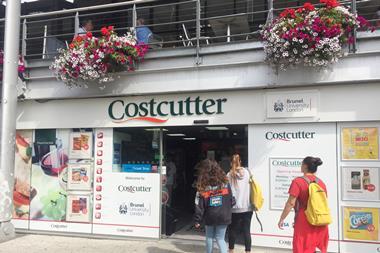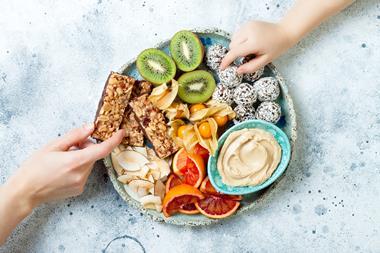Our Champions understand that millennials are the future, making them an essential demographic to capture. Here’s how they do it
Jai Singh, owner of MJ’s Go Local Extra, in Wheata Road, Sheffield
Younger shoppers love a Big Night In, says Jai, who has increased his alcohol range as a result
Arnaud Leudjou, retail manager at Costcutter Brunel University, London
Speed of service is the key for millennials and at Arnaud’s store shoppers use fingerprint payment
Donna Mullan, co-owner of two Spar stores in Armagh, N Ireland
Donna says this market is health obsessed and always keen to try new and unusual products
James Brundle, co-founder of Eat17, a chain of five stores
James is catering for younger shoppers’ demand for high-quality ingredients with its own-brand lines
What’s your understanding of a millennial? Do you get a lot of millennial shoppers in your store?
Jai: It’s basically anyone born in that era where they’ve grown up with technology. We do get a lot of them in our store. People in my generation – those coming to the age of 40 – are lucky that we haven’t grown up with it but have seen the change and have an understanding of the technology, whereas those older than us are a little less technologically minded.
Arnaud: Being in a university, millennials are definitely a big part of my shopper base.
James: Millennials, in my mind, are young working adults in their early 20s and 30s and, yes, we get a lot of young shoppers and young families in our stores.
Donna: We get quite a mix of shoppers, including a lot of younger people.
How have you changed your product range to suit their preferences?
Jai: We want to expand our spirits range to appeal to the at-home drinking trend. We’ve already moved out tobacco into the ceiling so we can devote the area behind the counter to alcohol, but we also want to add another shelf for alcohol. We sell exclusive and limited-editions gins and vodkas as we know these shoppers will buy these if they have seen them on social media. These shoppers are highly influenced by what they see online and are more likely to try something new only if they’ve seen someone else drinking it. The older generation is likely to buy something new only if they’ve been recommended it by a friend, or tried it in a bar or restaurant. We also want to add in more signage throughout the store to help drive shoppers around it – for example, we would like to put POS in the snacking section, asking “Have you picked up your beer?” and other reminders and guidance. I think millennial shoppers are more likely to come into the store with a set idea of what they need and just buy that item, whereas an older customer might have more time and might browse the store more.
Arnaud: We’ve extended our range of Eat Real crisps as these are vegan and gluten-free and are very popular. We also have a large range of Grenade Carb Killa bars as well as the shakes and Killa coffee, which are equally popular. We’ve noticed that millennial shoppers tend to like the big and well-known brands as they trust that they will offer high-quality products, and therefore they are happier to pay more for them.
James: We’ve launched our own Eat17 homemade range in response to the demand for fine quality, fresh, local food. The range, which includes ready meals, sandwiches, pastries and bread, is all freshly made in our in-store kitchens from scratch, and contain no added nasties. The millennial generation is not only conscious of what they eat, but also of how their actions as a consumer affect the environment. As part of this consciousness, there has been a large rise in veganism, so we have extended our vegan range in all of our stores. We also stock food from local suppliers as the younger generation are very keen to support local businesses and reduce the miles between the producer and themselves.
Donna: We started selling a pizza with half-fat cheese and we can barely keep it on the shelf! We were working on adding the calorie count to the meals we make in store for a while, but we had to stop that because it was too complicated and was taking far too much time. I’m sure providing calorie counts is something all retailers will have to do in the near future as people are so conscious of their calorie intake and many follow diet apps with set calorie counts per day.
A lot of npd is coming to market targeting the millennial market. Why is this such an important generation to appeal to?
Jai: They are important to us because they are our future, so retailers should try their best to get in new products that appeal to them. They want to keep their mix interesting as millennials will go somewhere else if they get bored of your offer. In terms of convenience, it’s no coincidence that the sector is still going strong with these shoppers as they tend to have a lot of extra disposable income and they are willing to pay a premium for the convenience of popping into a small local store.
Arnaud: For any retailer that’s forward thinking, they need to consider these shoppers as they start the trends and these are the trends that are going to continue.
James: They want better food. Also, lots of millennials are self-employed influencers who have a huge influence on their followers – so you never know who could pick up on your brand if you appeal to one of them.
Donna: They are the future, plus they have more surplus money to spend, they’re more open to new ideas and less set in their ways. Also, I think they are easier to manipulate so brands find it easier to make them think they need to buy their products. They tend to buy things even if they can’t afford them – they’ll just stick it on their credit card.
Have you made any changes to your store layout, services or the way you market the business to appeal to younger shoppers?
Jai: We have been using social media for about 10 years. We’ve moved away from Facebook a bit now and moved onto Snapchat and Instagram more, as we felt Facebook was becoming bombarded with promotional messages. We’ve also noticed people’s attention spans have greatly reduced on social media so they are unlikely to concentrate on a long post and would rather just see images and captions.
Arnaud: We have the Fingopay, which allows shoppers to pay with the touch of their finger. This is a very quick way to pay and sales increased by 11% in the first few months after launch.
James: Our stores are already geared towards people who love food, but we have started to introduce street food markets in our stores (in Bishop’s Stortford and Hammersmith), to feed the hunger for authentic street food as millennials return from their travels. The refillable services are in place as part of our sustainable food offering. The interiors of our stores are important to us, too, and we always make sure that they are ergonomic, interactive, interesting, enticing, and an environment where people genuinely want to be. We recognise that aesthetic appeal is particularly important to the younger generation. We’ve introduced refill units into our Walthamstow, Bishop’s Stortford and Hammersmith stores so people can re-use and refill containers for pasta, rice, cereal, wine, beer, nuts, sweets, tea, coffee and many more.
Donna: We haven’t recently made any changes to the layout or services in the store, but we hope to get a licence to sell alcohol soon.
What would your advice be to any retailer who wants to appeal more to the next generation of shoppers?
Jai: Watch younger shoppers to see if they seem to find everything they need in store, or if they are just walking straight back out without buying anything. They are less likely to come over and ask if they can’t find something they want to buy. It’s helpful to always greet customers as they walk in to ensure you’ve opened up that communication barrier so they feel more able to come and speak to you if they need to. Listen to suppliers and try new products and read the trade press for new ideas. We are currently negotiating with Parfetts on what craft beers we can have at a promotional price as we’re willing to take a hit on the margin in order to draw in these craft beer customers as I think these could offer a huge potential in terms of their Big Night In basket spend.
Arnaud: You’ve got to look at your local demographic because you don’t need to worry about appealing to younger shoppers if there aren’t any in your area. But if there are, then try to carry out a survey of what they want to see in your store. We did that and we got some new ideas, such as creating a section devoted to healthy products.
James: Keep an eye on the trends and focus on quality, honest products.
Donna: Follow the trends, even if you don’t think you need it or don’t think it will sell. I didn’t think I’d sell charcoal-infused black buns when I first saw them! I think big, gourmet, over-the-top sandwiches might be the next big thing. When I went to Dublin recently they were making sandwiches to order and I could barely fit one in my mouth, and it cost me 10 Euros! But Dublin is always where these trends start to filter through.
Trends
What trends do millennials follow?
Jai: Free-from products, gins, fresh meat, snacking products, craft beers, fresh coffee and protein bars and shakes. They love a Big Night In and like drinking at home. The days of the housewife buying all the groceries for the week and cooking a family meal every night have disappeared; these shoppers are much more likely to buy what they want to eat as they want to eat it, on the go. With so much food to go, ready meals and snack products available, it’s easy for them to eat wherever they are going and this suits their busy lifestyles. These shoppers will also buy things that will look good on social media.
Arnaud: They like to buy healthy foods, vegan and gluten-free products, and there’s a high demand for international flavours. They like Oriental noodles and snacks with flavours from other countries. Protein is another big thing for them and they’ll happily spend more on a product because it has added protein.
James: We’ve found this generation to be more interested in cooking meals from scratch and buying raw ingredients, rather than stereotypically ‘bad for you’ instant ready meals. This could be due to an increased awareness in the importance of eating healthily, as well as caring about the provenance of ingredients.
Donna: Armagh just seems to have gone fitness crazy. We’ve had lots of new gyms and cycling and running clubs opening. People just want to run in, grab their protein bar or quick easy meal, then run out again.
Product range
What products do millennials like to buy and how do they like to shop?
Jai: They like to get in and out quite quickly. I’ve been told by these shoppers that they don’t like to go to the mults as then they have to drive there, park, navigate the big store, queue up to pay, and the process is much more lengthy than coming to a c-store. They like to buy snacks they can take to the office to share with colleagues, plus ready-made sandwiches and porridge pots where they can just add hot water when they get to the office.
Arnaud: Their focus is on speed of service. They expect to see an option for self-service and to be able to use their phones to make payments. We had an issue with this payment method for a couple of weeks and it had a big hit on sales. We found that shoppers don’t carry debit cards so they couldn’t even get cash out.
James: A lot of younger people tend not to do a weekly shop and will buy as and when they need things, or when they want to impulse buy things they fancy. We’ve introduced refill units to our Walthamstow, Bishop’s Stortford and Hammersmith stores so people can re-use and refill containers to reduce single-use plastics. Using containers also means that they only have to buy as much as they need.
Donna: They like their trendy foods. We’ve started selling buns where the bread has been infused with beetroot, charcoal or pesto, so they’re purple, black or green. The younger shoppers love them.


















![C-Store_Champions_logo-CHOSEN[1] 2023](https://d2dyh47stel7w4.cloudfront.net/Pictures/380x253/6/5/7/301657_cstore_champions_logochosen12023_817064.jpg)




No comments yet